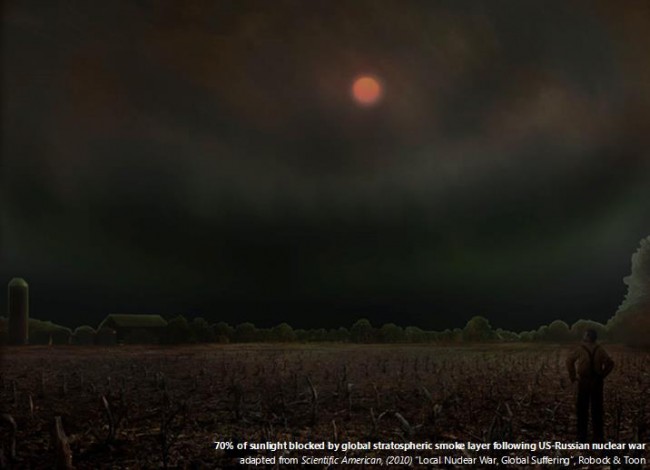
Nuclear War, Nuclear Winter, and Human Extinction
While it is impossible to precisely predict all the human impacts that would result from a nuclear winter, it is relatively simple to predict those which would be most profound. That is, a nuclear winter would cause most humans and large animals to die from nuclear famine in a mass extinction event similar to the one that wiped out the dinosaurs.
Following the detonation (in conflict) of US and/or Russian launch-ready strategic nuclear weapons, nuclear firestorms would burn simultaneously over a total land surface area of many thousands or tens of thousands of square miles. These mass fires, many of which would rage over large cities and industrial areas, would release many tens of millions of tons of black carbon soot and smoke (up to 180 million tons, according to peer-reviewed studies), which would rise rapidly above cloud level and into the stratosphere. [For an explanation of the calculation of smoke emissions, see Atmospheric effects & societal consequences of regional scale nuclear conflicts.]
The scientists who completed the most recent peer-reviewed studies on nuclear winter discovered that the sunlight would heat the smoke, producing a self-lofting effect that would not only aid the rise of the smoke into the stratosphere (above cloud level, where it could not be rained out), but act to keep the smoke in the stratosphere for 10 years or more. The longevity of the smoke layer would act to greatly increase the severity of its effects upon the biosphere.
Once in the stratosphere, the smoke (predicted to be produced by a range of strategic nuclear wars) would rapidly engulf the Earth and form a dense stratospheric smoke layer. The smoke from a war fought with strategic nuclear weapons would quickly prevent up to 70% of sunlight from reaching the surface of the Northern Hemisphere and 35% of sunlight from reaching the surface of the Southern Hemisphere. Such an enormous loss of warming sunlight would produce Ice Age weather conditions on Earth in a matter of weeks. For a period of 1-3 years following the war, temperatures would fall below freezing every day in the central agricultural zones of North America and Eurasia. [For an explanation of nuclear winter, see Nuclear winter revisited with a modern climate model and current nuclear arsenals: Still catastrophic consequences.]
Nuclear winter would cause average global surface temperatures to become colder than they were at the height of the last Ice Age. Such extreme cold would eliminate growing seasons for many years, probably for a decade or longer. Can you imagine a winter that lasts for ten years?
The results of such a scenario are obvious. Temperatures would be much too cold to grow food, and they would remain this way long enough to cause most humans and animals to starve to death.
Global nuclear famine would ensue in a setting in which the infrastructure of the combatant nations has been totally destroyed, resulting in massive amounts of chemical and radioactive toxins being released into the biosphere. We don’t need a sophisticated study to tell us that no food and Ice Age temperatures for a decade would kill most people and animals on the planet. Would the few remaining survivors be able to survive in a radioactive, toxic environment?
It is, of course, debatable whether or not nuclear winter could cause human extinction. There is essentially no way to truly “know” without fighting a strategic nuclear war. Yet while it is crucial that we all understand the mortal peril that we face, it is not necessary to engage in an unwinnable academic debate as to whether any humans will survive.
What is of the utmost importance is that this entire subject –the catastrophic environmental consequences of nuclear war – has been effectively dropped from the global discussion of nuclear weaponry. The focus is instead upon “nuclear terrorism”, a subject that fits official narratives and centers upon the danger of one nuclear weapon being detonated – yet the scientifically predicted consequences of nuclear war are never publically acknowledged or discussed.
Why has the existential threat of nuclear war been effectively omitted from public debate? Perhaps the leaders of the nuclear weapon states do not want the public to understand that their nuclear arsenals represent a self-destruct mechanism for the human race? Such an understanding could lead to a demand that nuclear weapons be banned and abolished.
Consequently, the nuclear weapon states continue to maintain and modernize their nuclear arsenals, as their leaders remain silent about the ultimate threat that nuclear war poses to the human species.
Steven Starr is the director of the University of Missouri’s Clinical Laboratory Science Program, as well as a senior scientist at the Physicians for Social Responsibility. He has been published in the Bulletin of the Atomic Scientists and the Strategic Arms Reduction (STAR) website of the Moscow Institute of Physics and Technology; he also maintains the website Nuclear Darkness. Starr also teaches a class on the Environmental, Health and Social Effects of nuclear weapons at the University of Missouri.
A military depot in central Belarus has recently been upgraded with additional security perimeters and an access point that indicate it could be intended for housing Russian nuclear warheads for Belarus’ Russia-supplied Iskander missile launchers.
The Indian government announced yesterday that it had conducted the first flight test of its Agni-5 ballistic missile “with Multiple Independently Targetable Re-Entry Vehicle (MIRV) technology.
While many are rightly concerned about Russia’s development of new nuclear-capable systems, fears of substantial nuclear increase may be overblown.
Despite modernization of Russian nuclear forces and warnings about an increase of especially shorter-range non-strategic warheads, we do not yet see such an increase as far as open sources indicate.